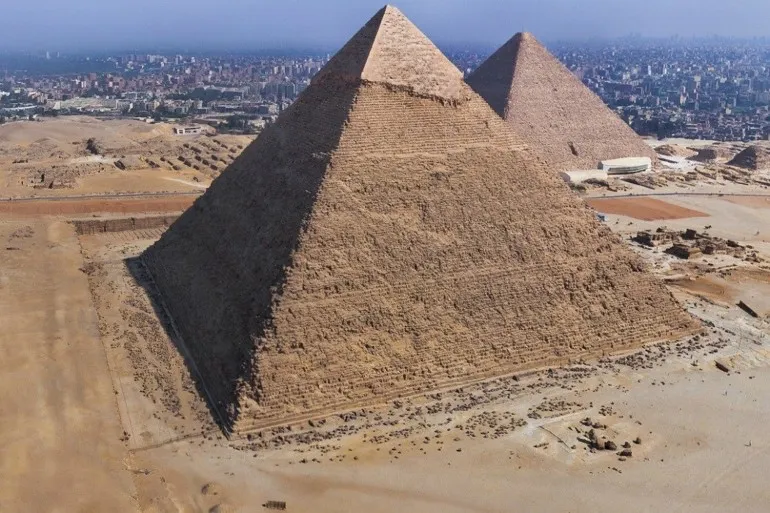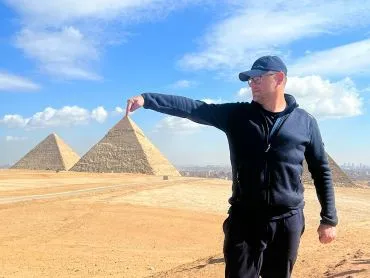Facts About Khafre Pyramid
The Khafre Pyramid stands as one of Egypt’s most iconic and historically significant monuments. Constructed during the Old Kingdom of Egypt, it remains a testament to the architectural brilliance of ancient Egyptian civilization. Here’s an in-depth exploration of the pyramid and its surrounding complex, shedding light on its design, purpose, and enduring legacy.
9 Fascinating Facts About Khafre Pyramid
The Khafre Pyramid stands as one of Egypt’s most iconic and historically significant monuments. Constructed during the Old Kingdom of Egypt, it remains a testament to the architectural brilliance of ancient Egyptian civilization. Here’s an in-depth exploration of the pyramid and its surrounding complex, shedding light on its design, purpose, and enduring legacy.
Khafre Pyramid and its Historical importance
The Khafre Pyramid has an important place in Egypt’s history. The pyramid belonged to Pharaoh Khafre, a king from the 4th Dynasty. The second biggest of the Giza pyramids, it’s 143.5 m (471 ft) tall. This pyramid is believed to symbolize the political and spiritual power of Khafre and together with the Giza Necropolis, showcases the wealth and culture of Egypt at the time.
The Structure and Design of the Khafre Pyramid
Khafre Pyramid's design reflects royal power and God-kind link through stones, inscriptions and other causes. With a few original casing stones at its peak, you can see what the pyramid originally looked like before it lost these. The angle of the pyramid which is a little steeper than that of the Great Pyramid of Khufu was chosen to keep it balanced. The Egyptians knew a lot about maths and building. They lined it up perfectly with the four directions and used big blocks of limestone.
The purpose and function of Khafre Pyramid will be discussed in this article
The Khafre Pyramid was a tomb for Pharaoh Khafre. However, it served more than a resting place for the king. The pyramid was supposed to be a part of a larger plan for the afterlife, linking the earth and the immortals. The area around the pyramid has a causeway and valley temple as well as the Great Sphinx. They imply that Khafre’s afterlife was an extension of that same power on Earth. Some scholars think the pyramid may have made a statement that the pharaoh was a god.
Khafre's Pyramid is Different from Other Pyramids Because of
The Khafre Pyramid differs from other pyramids in Giza the Great Sphinx next to it is thought to represent Khafre himself. Unlike the Pyramid of Khufu which has no more work of art than a big stone, the Pyramid of Khafre has a causeway, mortuary temple, and Sphinx. The structures are not only a tomb but also symbols of the pharaoh's powerful divine spirit.
The Great Sphinx and Khafre Pyramid are closely linked to one another
The Great Sphinx, next to Khafre’ Pyramid, has a significanct meaning to the pyramid itself. The gigantic statue of the Sphinx which has a lion’s body and pharaoh’s head is believed to be a depiction of Khafre himself. It was meant to safeguard and ensure Khafre’s power in the afterlife. The Sphinx also aligns flawlessly with the entrance to the causeway that leads to the valley temple, creating an awe inspiring link between the living and the divine.
How They Built the Khafre Pyramid.
The ancient Egyptians were knowledgeable builders. The Khafre Pyramid’s construction confirms this knowledge. It is thought the pyramid was built using ramps to move the huge stone blocks into position. The Giza Plateau nearby was where workers quarried and cut these blocks. The precision of the positioning and the alignment of the pyramid towards the stars indicate a high degree of planning and engineering .Gold and Silver Treasures, Coins, Jewelry, and Scarabs
The area around the Khafre Pyramid yielded numerous artefacts with statues, pottery and inscriptions discovered by archaeologists. Many of these items were found in the valley temple, where Khafre was once believed to have been mummified and buried. The archaeologists haves discovered Old Kingdom artifacts that provide insight into the use of the complex.
Khafre pyramid and its impact on modern culture and tourism
People from all walks of life visit the Khafre Pyramid. Most noticeably, it’s archaeologists and historians. It is frequented by millions every year as part of the wider Giza complex. The sheer size, history and features like the Great Sphinx of the Khafre Pyramid make it one of Egyptian’s most important cultural landmarks. The Great Pyramid is an incredible feat of engineering. It has been built with such precision that it still holds important significance today.
The Pyramid of Khafre is a historical artifact of detainment in Egypt.
The Pyramid of Khafre is one of the archaeological landmarks in the ancient Egyptian civilization. Architectural genius of the Ancient Egyptians, as the pyramid is still used today. The architectue master piece lies in the pyramid complex in Giza. The pyramid from phaor khafre era where pyramid built in his era. Although the pyramid of Khafre is mostly said to be larger than the pyramid of Khufu, it is actually 10 meters shorter. This is due to an engineering miracle that was caused by it being built on a high base. The high base causes the pyramid to look taller and thus, highlights the wonder of architecture in ancient Egypt. The builders of the pyramid were clever enough to use the natural terrain to add greatness to the final result and is a surprisingly effective visual effect. The Pyramid of Khafre has lost its limestone covering at the top but it is still easy to imagine the grandeur of the pyramid. The Egyptians dealt with a lot of obstacles in the hard work of building the pyramids. The Pyramid of Khafre is a royal tomb. It is built based on the beliefs of the ancient Egyptians about immortality. The pyramid was viewed as the passage of the soul of the pharaoh to the other world. The limestone coating at the top and still existent today testifies to The greatness of The pyramid indicates how the Pharaohs were ingenious in the engineering use of construction. Building the Great Pyramid did not only require have expert skills. But also involved the coordination of thousands of workers, tools, and techniques. Therefore, we see that the ability of the Pharaohs to mobilize their resources shows their engineering ingenuity. It also probably helped to strengthen their economic and political power. Moreover, these are achievements that have defied great length of time and distance.
What was the purpose of Khafre's Pyramid
The pyramid that has a misty look and is slightly smaller than Khufu’s pyramid is called the Pyramid of Khafre. According to ancient Egyptians, the pyramid was built so that the Pharaoh could reach the afterlife safely. The pyramid was also a symbol of royal power, divine authority and the pharaoh's status as a sacred and worshipped ruler.
How was Khafre's pyramid constructed
The limestone blocks used in the construction of the Pyramid of Khafre were brought from Giza quarries. Though the engineering techniques available during those times were not as advanced either, the ancient Egyptians still knew how to move the heavy stones. Copper and hard stone tools were employed to carve and shape the rocks. For the construction of the pyramid workers, there were thousands. These workers worked in a very organized manner. Further, to complete the pyramid in a short time efforts were coordinated.
What does the Khafre Pyramid stand for
The Pyramid of Khafre is a representation of royal authority and divine rule. In addition, This Pyramid symbolically represents eternal life. The pyramid also indicates ancient Egyptians’ advance social and religious system where the pharaohs were deemed as the link between the gods and the mortals. Also, the architectural design of the pyramid demonstrates the engineering capabilities of the Egyptians as well as their ability to execute large-scale projects that still exists today.
What is the link between the Pyramid of Khafre and the Sphinx
The Pharaoh Khafre built the Pyramid of Khafre and the Sphinx. It is possible that the Great Sphinx of Giza was built during the reign of Pharaoh Khafre. Also, the face of the Sphinx seems to represent the face of Khafre himself. The Sphinx is fronting the Pyramid of Khafre as a guardian of the pyramid and the whole pyramid complex enhancing the symbolism of protector and royal power.
The Sphinx shows an unusual blend of human and animal power. Its human head is a fitting tribute to royalty, while its lion body symbolizes impressive power. As such, the Sphinx protects temples and royal tombs. Ancient Egyptians placed a lot of importance on the Sphinx symbol, as they believed that it wards off evil spirits and ensures the protection of the pharaoh and pyramids in the afterlife.
The Sphinx and the pyramid of Khafre are connected to one another. Thus, the Sphinx became part of the pyramid complex and the spirit of the Sphinx represents the religion and culture of that time. Also, it highlights the king as well as protects the afterlife and cosmic order.
The size and measurements of the Khafre’s pyramid.
The Pyramid of Khafre is the second-largest of the Giza pyramids and stands out for its size and unique engineering design. I hope the aforementioned has helped you go through detailed Khafre Pyramid Facts. This pyramid is measured as follows.
Original height.
The height of the Pyramid of Khafre was originally 143.5 meters (471 feet).
Its height is currently approx. 136.4m (448 ft) due to the loss of part of the upper casing over time.
Base length.
The side of the point at the top of the pyramid is about 215.25 meters (706 feet).
Tilt angle.
The pyramid has an angle of inclination equal to 53.2°. This gives it a steeper profile than the Pyramid of Khufu.
Total area.
The pyramid's base takes up about 46,000 square meters.
External casing.
The pyramid was once covered with limestone and some of these (earlier) top layers are still there giving it a unique look.
The Pyramid of Khafre is an engineering achievement. In fact, its size shows the precision of planning and engineering skill. So, the ancient Egyptians created a great contemporary monument.
Conclusion
The Khafre Pyramid stands as an extraordinary testament to the ingenuity, ambition, and spiritual beliefs of ancient Egypt. More than just a tomb, it is a symbol of Pharaoh Khafre’s power, both on Earth and in the afterlife. The pyramid’s unique architectural features, including the accompanying Great Sphinx and its alignment with celestial bodies, reveal the sophisticated knowledge of the builders and their deep connection to the divine.
The pyramid’s legacy lives on, continuing to captivate visitors, scholars, and tourists from around the world. Its historical significance, combined with the grandeur of the surrounding complex, makes it one of Egypt’s most cherished cultural landmarks. Whether you're an archaeology enthusiast or simply someone fascinated by the mysteries of ancient civilizations, the Khafre Pyramid offers an awe-inspiring experience that reflects the enduring legacy of one of history’s greatest cultures.
Discover More About This Ancient Wonder with Luxreisen
Book now




_lg.webp)

_lg.webp)

_lg.webp)
